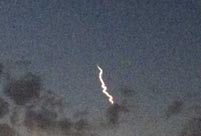

WELLINGTON, Jan. 7-- A magnitude-6 quake that shook New Zealand's central South Island on Tuesday is unlikely to have increased the chance of a rupture on the major Alpine Fault, seismologists said Wednesday.
The newly-named "Wilberforce earthquake" had an intensity rated as severe when it struck at 6:48 a.m. at a depth of 5 km in an area about 30 km west of Arthur's Pass in the Southern Alps.
The epicenter was about 20 km to the east of the Alpine Fault, the on-land boundary between the Pacific and Australian tectonic plates, according to the government's Institute of Geological and Nuclear Sciences (GNS Science).
In a preliminary study, seismologists found the Wilberforce earthquake had increased the stress on parts of the Alpine Fault and reduced the amount of stress elsewhere.
Overall, any impact on the fault had been extremely minor and has not changed the likelihood of a rupture.
"The chances of the Alpine Fault rupturing are the same as they were a week ago. Tuesday's quake is unlikely to have increased the chances of a rupture," said GNS Science geodesist Ian Hamling.
In the mid-1990s, three earthquakes over magnitude 6 struck at Arthur's Pass and they had no measurable impact on the Alpine Fault.
"We monitor the Alpine Fault long-term for any signs of increased earthquake activity. There has been no change in activity this week."
The Alpine Fault ruptures once every 330 years on average, although intervals between ruptures can vary between 140 and 450 years. Its last rupture occurred 298 years ago producing an earthquake of about magnitude 8.
It has a 28 percent chance of rupturing in the next 50 years, which is high by global standards, according to GNS Science.
An international team of scientists is currently drilling a 1.3- km-deep hole into the Alpine Fault to provide the scientific data required to improve understanding of the largest seismic hazard in the South Island.
 PLA soldiers operating vehicle-mounted guns in drill
PLA soldiers operating vehicle-mounted guns in drill Beauties dancing on the rings
Beauties dancing on the rings Blind carpenter in E China's Jiangxi
Blind carpenter in E China's Jiangxi Top 10 highest-paid sports teams in the world
Top 10 highest-paid sports teams in the world In photos: China's WZ-10 armed helicopters
In photos: China's WZ-10 armed helicopters UFO spotted in several places in China
UFO spotted in several places in China Certificates of land title of Qing Dynasty and Republic of China
Certificates of land title of Qing Dynasty and Republic of China  Cute young Taoist priest in Beijing
Cute young Taoist priest in Beijing New film brings Doraemon's life story to China in 3D
New film brings Doraemon's life story to China in 3D China-S.Korea FTA sets positive precedent
China-S.Korea FTA sets positive precedent Ferry carrying 458 people sinks in Yangtze River
Ferry carrying 458 people sinks in Yangtze River Mecca of Marxism
Mecca of Marxism Bring them home
Bring them homeDay|Week